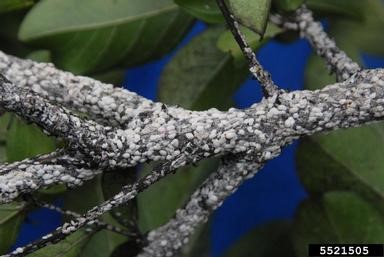January 2022 – Crape Myrtle Bark Scale
The topic this month should be of concern to many of us and our neighbors as a fair number of us have crepe myrtle bushes and trees in our yards.
A recently introduced insect pest, the crape myrtle bark scale (CMBS), initially infested crape myrtles in Texas in 2004 and has now spread to several southern states. It has been found in Baldwin County and other parts of the state of Alabama.

Fortunately, the pest is mainly an aesthetic issue and will probably not kill the plant. The plant will not be as vigorous, may have fewer flowers and smaller clusters of flowers, will be late in leafing out, and have a white-scale infestation. This white scale, see Figure 1, may look like honeydew produced by aphids. The branches will become covered with black sooty mold
Proper care of the plant will minimize infestation. There are several spray and soil systemic insecticides available for treatment. If the plant is heavily infested the trunk and branches may be washed with a mild detergent to remove the scale and mold. Make sure to scout your trees on a monthly basis to be proactive with this pest.
The following two references will give you more detailed information about CMBS, treatment, and symptoms:
- https://hgic.clemson.edu/factsheet/crapemyrtle-bark-scale/
- https://agrilife.org/citybugstest/files/2010/05/EHT-049-Crape-myrtle-bark-scale.pdf
If you notice symptoms of scale insect infestation on your crape myrtles, please contact the local office of the Alabama Cooperative Extension Service at: Phone: (251) 937-7176 or you can email Jack LeCroy, Regional Extension Agent at: jml0003@auburn.edu